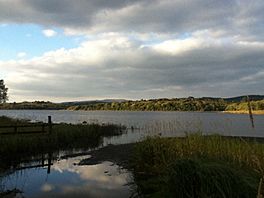Belhavel Lough facts for kids
Quick facts for kids Belhavel Lough |
|
|---|---|
 |
|
| Location | County Leitrim |
| Coordinates | 54°12′31″N 8°11′1″W / 54.20861°N 8.18361°W |
| Native name | Claonloch Error {{native name checker}}: parameter value is malformed (help) |
| Primary outflows | Diffagher River |
| Catchment area | 22.24 km2 (8.6 sq mi) |
| Basin countries | Ireland |
| Surface area | 1.01 km2 (0.39 sq mi) |
| Surface elevation | 60 m (200 ft) |
Belhavel Lough is a beautiful freshwater lake found in the northwest of Ireland. Its name in Irish, Claonloch, means "crooked lake." This lovely lake is located in the northern part of County Leitrim, close to the small village of Killarga.
Contents
Discovering Belhavel Lough's Location
Belhavel Lough is easy to find in County Leitrim. It sits about 2 kilometres (1.2 mi) south of Killarga village. You can also find it about 5 km (3.1 mi) north of another town called Drumkeeran.
How Water Flows Through Belhavel Lough
This lake covers an area of about 1.01 km2 (0.4 sq mi). Water from Belhavel Lough flows out towards the east. It joins the Diffagher River, which then travels on to reach the larger Lough Allen. This shows how different waterways are connected!
Understanding Belhavel Lough's Environment
The health of a lake's environment is called its ecology. For Belhavel Lough, scientists have studied its water quality over the years.
Water Quality and Health
Around 2001 to 2003, the water in Belhavel Lough was considered to be in good condition. It had a "mesotrophic" rating, which means it had a moderate amount of nutrients. However, by 2007 to 2009, its ecological status was reported as "poor." This suggested there might be some pollution affecting the lake's health.
Threats from Invasive Species
The environment of Belhavel Lough, like many other waterways in Leitrim, faces challenges from certain plants and animals. These are called invasive species because they are not native to the area and can harm the local ecosystem.
Common Invasive Species
- Curly waterweed: This plant grows very fast and can block out sunlight for other plants.
- Zebra mussel: These small mussels attach to surfaces and can filter out food needed by native species.
- Freshwater clam: Another type of clam that can outcompete native clams for resources.
It's important to protect lakes like Belhavel Lough from these invaders to keep their ecosystems healthy!


